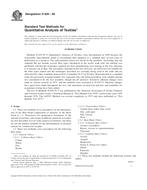Potrebujeme váš súhlas na využitie jednotlivých dát, aby sa vám okrem iného mohli ukazovať informácie týkajúce sa vašich záujmov. Súhlas udelíte kliknutím na tlačidlo „OK“.
ASTM G24-13
Standard Practice for Conducting Exposures to Daylight Filtered Through Glass
Automaticky preložený názov:
Štandardná prax pre dirigovanie expozície, ktoré majú denné svetlo sa filtruje cez sklo
NORMA vydaná dňa 1.6.2013
Informácie o norme:
Označenie normy: ASTM G24-13
Poznámka: NEPLATNÁ
Dátum vydania normy: 1.6.2013
Kód tovaru: NS-57617
Počet strán: 6
Približná hmotnosť: 18 g (0.04 libier)
Krajina: Americká technická norma
Kategória: Technické normy ASTM
Kategórie - podobné normy:
Anotácia textu normy ASTM G24-13 :
Keywords:
aging, exposure, glass, ultraviolet, weathering, lightfastness, fading, solar radiation, ICS Number Code 59.080.01 (Textiles in general)
Doplňujúce informácie
| Significance and Use | ||||||||||||||||||||||||
|
4.1 Since solar radiation, air temperature, relative humidity, and the amount and kind of atmospheric contaminants vary continuously, results from exposures based on elapsed time may differ. The variations in the results may be minimized by timing the exposures in terms of: 4.1.1 One or more environmental parameters such as solar radiant exposure, or 4.1.2 A predefined property change of a weathering reference specimen with known performance. 4.2 Variations in temperature, moisture and atmospheric contaminants can have a significant effect on the degradation caused by solar radiation. In addition, exposures conducted at different times of the year can cause large differences in rate of degradation. Different materials may have different sensitivities to heat, moisture, and atmospheric contaminants, which may explain differences in rankings of specimens exposed to equivalent solar radiant exposure when other environmental conditions vary. 4.3 Since the method of mounting may influence the temperature and other parameters during exposure of the specimen, there should be a mutual understanding as to the method of mounting the specimen for the particular exposure test under consideration. 4.4 There can be large differences among various single strength window glasses in their transmittance in the 300 to 350 nm region. For example, at 320 nm, the percent transmittance for seven different lots of single strength window glass ranged from 8.4 to 26.8 %. At 380 nm, the percent transmittance ranged from 84.9 % to 88.1 %.6 4.5 Differences in UV transmittance between different lots of glass persist after solarization. The largest differences among window glasses in UV transmittance are in the spectral range of 300 to 320 nm. 4.6 This practice is best used to compare the relative performance of materials tested at the same time behind the same lot of glass. Because of variability between lots of glass and between exposures conducted at different times of the year, comparing the amount of degradation in materials exposed for the same duration or radiant exposure at separate times, or in separate fixtures using different lots of glass is not recommended. 4.7 It is strongly recommended that at least one control material be exposed with each test. The control material should be of similar composition and construction. and be chosen so that its failure modes are the same as that of the material being tested. It is preferable to use two control materials, one with relatively good durability, and one with relatively poor durability. If control materials are included as part of the test, they shall be used for the purpose of comparing the performance of the test materials relative to the controls. 4.8 There are other standards which describe exposures to glass filtered daylight. Six cited standards are D3424, D4303,D6901, ISO 105-B01, ISO 877-1, ISO-877-2, AATCC TM 16C. 4.9 Because of the possibility that certain materials may outgas during exposure, it is recommended that only similar materials be exposed in the same under glass cabinet at the same time. |
||||||||||||||||||||||||
| 1. Scope | ||||||||||||||||||||||||
|
1.1 This practice evaluates the resistance of nonmetallic materials to solar radiation filtered through glass in passively ventilated and non-vented enclosures. For exposures in under glass enclosures with forced air circulation, refer to Practice G201. 1.2 For direct exposures, refer to Practice G7. 1.3 This practice is limited to the method of conducting the exposures. The preparation of test specimens and evaluation of results are covered in various standards for the specific materials. 1.4 Exposure conducted according to this practice can use two types of exposure cabinets. 1.4.1 Type A—A cabinet that allows passive ventilation of specimens being exposed behind glass. 1.4.2 Type B—Enclosed cabinet with exterior painted black that does not provide for ventilation of specimens exposed behind glass. Exposures conducted using a Type B cabinet are typically referred to as “black box under glass exposures.” 1.5 Type A exposures of this practice are technically similar to Method B of ISO 877-2. 1.6 The values stated in SI units are to be regarded as the standard. The inch-pound units given in parentheses are for information only. 1.7 This standard does not purport to address all of the safety concerns, if any, associated with its use. It is the responsibility of the user of this standard to establish appropriate safety and health practices and determine the applicability of regulatory limitations prior to use. |
||||||||||||||||||||||||
| 2. Referenced Documents | ||||||||||||||||||||||||
|
Podobné normy:
Historická
1.6.2010
Historická
1.12.2012
Historická
1.6.2013
Historická
1.1.2011
Historická
1.1.2013
Historická
1.8.2008



 ASTM D5253-04(2010)e..
ASTM D5253-04(2010)e.. ASTM D5426-12
ASTM D5426-12 ASTM D5548-13
ASTM D5548-13 ASTM D5591-04(2011)..
ASTM D5591-04(2011).. ASTM D5822-13
ASTM D5822-13 ASTM D629-08
ASTM D629-08
 Cookies
Cookies
